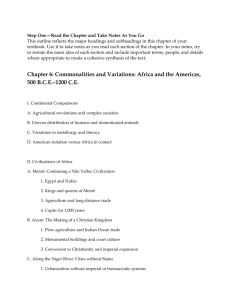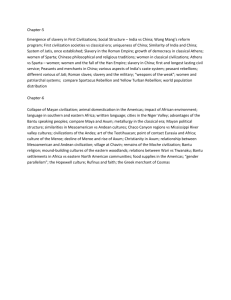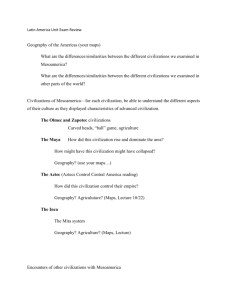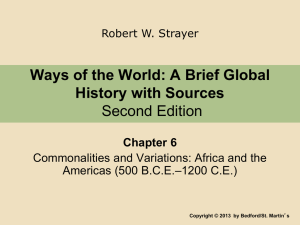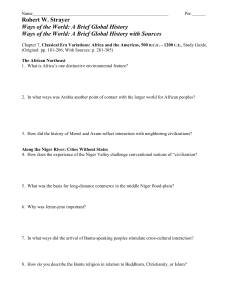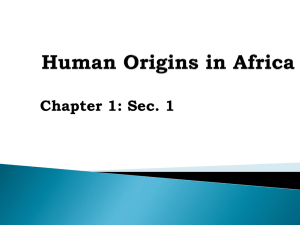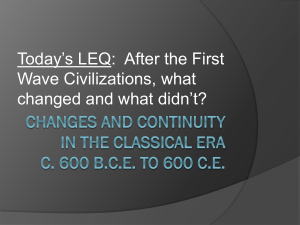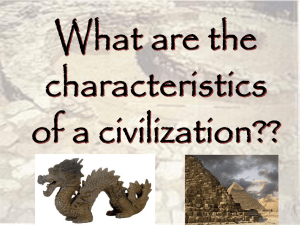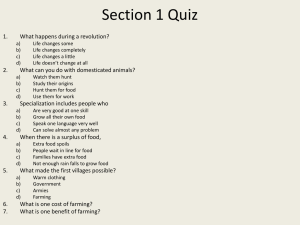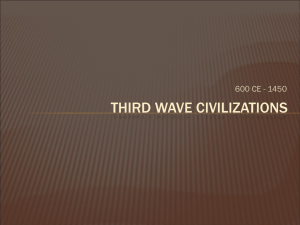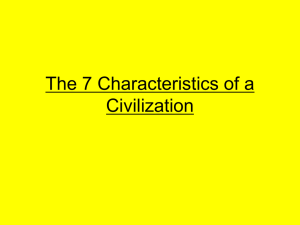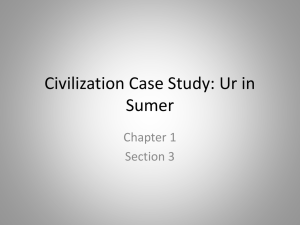File
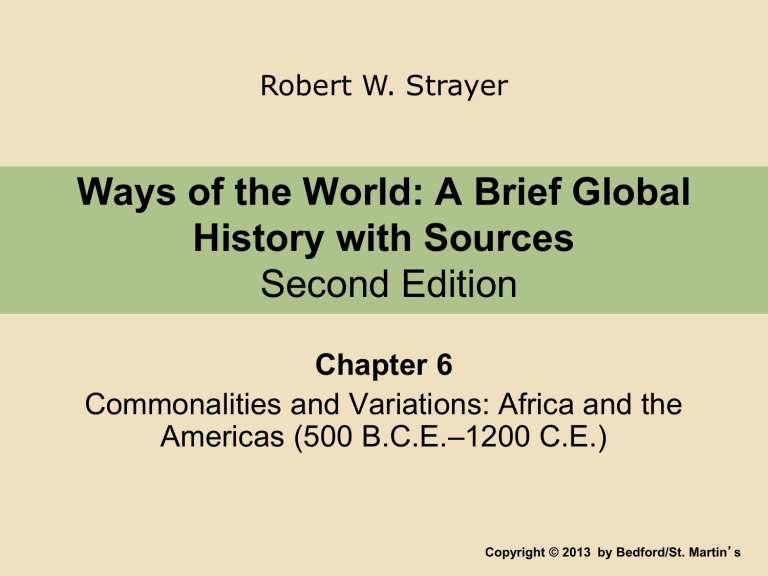
Robert W. Strayer
Ways of the World: A Brief Global
History with Sources
Second Edition
Chapter 6
Commonalities and Variations: Africa and the
Americas (500 B.C.E.
–1200 C.E.)
Copyright © 2013 by Bedford/St. Martin ’ s
I. Continental Comparisons
A. Agricultural revolutions and complex societies
B. Uneven distribution of humans and domesticated animals
C. Variations in metallurgy and literacy
D. American isolation versus Africa in contact
II. Civilizations of Africa
A.
Meroë: Continuing a Nile Valley Civilization
1. Egypt and Nubia
2.
Kings and queens of Meroë
3. Agriculture and long-distance trade
4. Coptic for 1,000 years
II. Civilizations of Africa
B. Axum: The Making of a Christian Kingdom
1. Plow agriculture and Indian Ocean trade
2. Monumental buildings and court culture
3. Conversion to Christianity and imperial expansion
II. Civilizations of Africa
C. Along the Niger River: Cities without States
1. Urbanization without imperial or bureaucratic systems
2. Iron working and other specializations
3. Regional West African trade system
III. Civilizations of Mesoamerica
A. The Maya: Writing and Warfare
1. As early as 2000 B.C.E.
2. Urban centers, mathematics, and astronomy
3. Engineered agriculture
4. Competing city-states
5. A century of collapse after 840 B.C.E.
III. Civilizations of Mesoamerica
B.
Teotihuacán: The Americas ’ Greatest City
1. Planned, enormous, and still a mystery
2. 150 B.C.E.
–650 C.E.
3. 100,000 –200,000 inhabitants in 550 B.C.E.
IV. Civilizations of the Andes
A. Chavin: A Pan-Andean Religious Movement
1. Temple complexes centered around a village
2. Village became a major religious center
3. Links to all directions via trade routes
IV. Civilizations of the Andes
B. Moche: A Civilization of the Coast
1. 250 miles of coast, 100 –800 C.E.
2. Elite class of warrior-priests
3. Rich fisheries and river-fed irrigation
4. Fine craft skills
5. Fragile environment
IV. Civilizations of the Andes
C. Wari and Tiwanaku: Empires of the Interior
1. 400 –1000 C.E.
2. Highland centers with colonies in the lowlands
3. Distinctions between the two, yet little conflict
4. Collapse, but the basis for the late Inca
V. Alternatives to Civilization:
Bantu Africa
A. Cultural Encounters
1. Migrations spread a common Bantu culture
2. Bantu strengths: numbers, disease, and iron
3. Bantu impact on the Batwa
4. Impacts on the Bantu in East Africa
V. Alternatives to Civilization:
Bantu Africa
B. Society and Religion
1. Wide varieties of Bantu cultures developed, 500 –1500
2. Less patriarchal gender systems
3. Ancestor or nature spirits rather than a Creator God
4. Localized not universal faiths and rituals
VI. Alternatives to Civilization: North
America
A. The Ancestral Pueblo: Pit Houses and Great Houses
1. Slow start to agriculture and settled society
2. Chaco Phenomenon, 860 –1130 C.E.
3. Astronomy and art but then warfare and collapse
VI. Alternatives to Civilization: North
America
B. Peoples of the Eastern Woodlands: The Mound
Builders
1. Independent agricultural revolution
2. Burial mounds of the Hopewell culture
3. Cahokia, 900 –1250 C.E.
4. Social complexity but weaker cultural unity
VII. Reflections: Deciding What ’ s
Important: Balance in World History
A. What gets included in world history and what gets left out?
B. Duration? Population? Influence? Evidence?
C. Location of historian and audience?
D. No consensus on a proper balance
